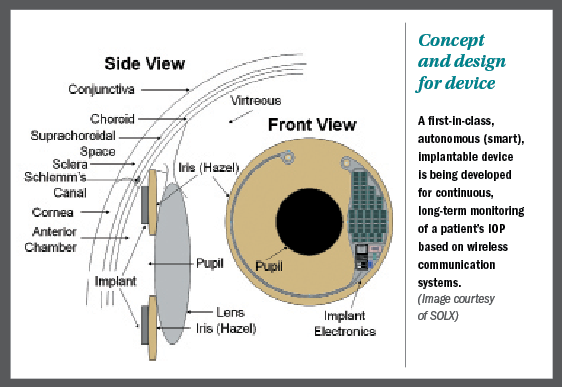Article
Round-the-clock IOP measurement becoming reality with technologic advances
The development of a device for 24-hour IOP monitoring is unique in that it can do so autonomously, without direct patient interaction, and can take measurements without external control signals.
Take-home
The development of a device for 24-hour IOP monitoring is unique in that it can do so autonomously, without direct patient interaction, and can take measurements without external control signals.

Dr. Moster
By Michelle Dalton, ELS; Reviewed by Marlene Moster, MD
Philadelphia-An ongoing conundrum for glaucoma specialists has been an inability to monitor patients throughout a 24-hour period in real-world clinical settings. About a decade ago, investigators started looking beyond the office readings and found IOP increased at night during sleep.
“That was quite a paradigm shift, as we used to believe that the pressure increased early in the morning when cortisol levels rose,” said Marlene Moster, MD, professor of ophthalmology, Thomas Jefferson University School of Medicine, Philadelphia. What diurnal studies on patients with glaucoma went on to find is that extrapolating IOP from one eye to the other is ineffective, as each eye operates independently.

“When the pressure rises in one eye, it may rise in the other but not as much,” Dr. Moster said. “Even a diurnal pressure curve in patients with primary open-angle glaucoma poorly describes IOP fluctuations. Therefore, it is almost impossible to predict the IOP variability moving forward in time.“
Glaucoma specialists and researchers alike agree there is a substantial amount that is just not yet known about IOP-how heavy exercise may affect it, how inversion positions in yoga (or any position where the head is below the heart) may affect pressure, or how the pressure varies when new drops or therapies are introduced. Therapy is determined based on a fleeting moment’s worth of data, and may not be reflective of the dynamic nature of IOP in daily life.
Envisioning the possibilities
What if glaucoma specialists could monitor a patient 24/7? What if physical contact with the eye was not needed to get an accurate measurement? What if all that could be accomplished without office visits?
“The potential to have 24-hour IOP measurements for us is like having an A1C reading for diabetic patients,” Dr. Moster said.
To that end, SOLX is developing a first-in-class, autonomous (smart), implantable monitoring device for continuous long-term patient monitoring based on wireless communication systems (similar to Bluetooth or WiFi). In the most simplistic of descriptions, the technology would be implanted in the eye and could interact with a patient’s nearby smartphone or tablet (or a base station for those without phone/tablet access) to relay the information to the glaucoma specialist’s office.
Passive versus autonomous devices
The ability to monitor continuously was initially problematic from an engineering standpoint, said Doug Adams, founder, president, and chief executive officer of SOLX.
The earliest iterations needed a battery to function, and “that didn’t work, as there wasn’t enough power to work the electronics in the device and keep it small enough to be implanted,” Adams said.
But transforming the device into one that “slept” until it was within range of a wireless recharging unit “turned out to require very little power,” he said.
While SOLX is not the only company working on 24-hour monitoring devices, it is the only one that can do so autonomously, without direct patient interaction, and can take measurements without external control signals. SOLX funded grants for PhD-candidates from Purdue University to develop an ultra-low-power miniature implantable wireless pressure sensing system.
Eric Chow, PhD, based his thesis on the electromagnetic/wireless and integrated circuit design aspects of the technology, Adams said, quipping that physicians will need to learn a “host of new engineering terms” when these devices come to market.
A high-frequency transmitter integrated circuit was created, achieving “sufficient efficiency to draw minimal power from the limited onboard storage array while outputting a sufficiently large signal to overcome tissue-induced attenuation,” Dr. Chow and others wrote.1 They created two versions of the system-one using a low-temperature co-fired ceramic material for the substrate and the other used silicon for the substrate.
The prototype developed in Dr. Chow’s work was implanted in rabbits between the sclera and choroid layers in the suprachoroidal space. 1 The entire system combines the implant and the onboard microelectromechanical system (Figure 1).
“When you think about compliance and the difficulty older patients have, we wanted to create a device that the patient would only need to occasionally pass, within about 10 meters of a base unit,” Adams said. “This device captures data all day with no external user input.”
Other companies’ devices require active patient interaction, although the devices themselves are inactive (Table 1).
Dr. Moster believes the data can be distilled into a simple analysis to make it easier to remotely monitor patients.
“We’ll be able to monitor their therapies and ensure the drugs are truly effective,” she said. “We’ll understand if our treatments are active over a 24-hour period and if not, either change the drug combination, or decide if glaucoma surgery is the best solution.”
Defining the pieces
While SOLX engineers started formulating how to encapsulate the device, companies like Microsoft and Apple were inadvertently helping the technology along when they introduced smart phones and other communications devices.
“We challenged our engineers to do more than just measure and read IOP,” Adams said. “The requirements would be very specific. I wanted programmability where the doctor could select the requirements. Physicians can take a reading as little as once per hour, or up to 2,400 times per day.”
Because the device is implanted and not external, the FDA is concerned about biocompatibility, and SOLX “auditioned” several platforms, including PMMA, liquid crystal polymers (LCP), and titanium.
The LCP completely encapsulates the device, which makes it slightly larger than ideal, Adams said.
The group is still evaluating titanium and platinum to encapsulate the device. “The FDA is intently focused on safety outcomes,” Adams said. “We’re putting electronics inside the eye. They cannot leak, and we have to have a truly biocompatible package with significant longevity.”
Although the current device measures 3 × 5 mm, smaller devices are being developed, Adams said, with a belief that within 2 years the devices will be closer to 1 × 2 mm, and within 5 years, closer to 250 µm cubed.
“I think over time, glaucoma specialists are going to deliver this device inside the eye at the slit lamp,” he said.
Dr. Moster said additional studies would concentrate on the best placement for the device (anterior chamber, suprachoroidal space, for instance).
“The possibilities are very broad as to how we can place these in the eye and wirelessly gather data,” she said.
Another potential advantage for physicians is if the patient is away-out of town for a weekend, for instance-the device continues to store the readings and downloads the next time it’s in range of the home base unit, Adams said.
“We’re making this technology work without any interaction on the part of the patient,” he said. “The device can also function through a smart phone or other mobile device.”
Early results and potential applications
“This sensor technology can be applied to anywhere in the body where pressure needs to be measured-ophthalmology, cardiology, neurology, urology,” Adams said. “Over time, we’ll be able to network the devices so they can ‘talk’ to each other.”
Physicians in all specialties will have a greater understanding of how diseases interact and function inside the body, he noted.
SOLX has investigated the device in animal studies, in eyes, arteries, and will be investigating its potential in the spine to measure cerebrospinal fluid (CSF) pressure, Adams said. The group plans to implant three devices in one rabbit to see the interaction (if any) exists between the pressure levels.
Ideally, researchers would be able to determine the relationship between blood pressure and IOP, or between IOP and CSF, he said.
Human trials could start as early as next year, Adams said.
In animal studies, the device has been incredibly accurate, and “we think we can be within 0.5 mm Hg,” he said.
The device is not yet perfect-and drift is an issue for sensors. Over the course of several months, drift may contribute 1 to 5 mm Hg.
“That’s a huge difference that we need to overcome,” he said, but believes current developments will overcome overcome the issue altogether.
Dr. Moster said implantation in the future may be through 30-gauge needles (or smaller), and when injected into the anterior chamber, “it can fall into the bottom of the angle where we can see it easily with gonioscopy at the slit lamp.”
The casing will need to be non-reactive, so as not to incite any biologic issues once human studies are fully enrolled.
She also hopes the more information gathered about how IOP fluctuates throughout the day-and maybe in even smaller increments such as hours or minutes-the more clinicians will learn about the pathophysiology of glaucoma.
“We don’t know if normal tension or angle closure glaucomas are affected similarly throughout a 24-hour span as open-angle,” she said. “This technology has the potential to be our Holy Grail.”
Reference
1. Chow EY, Yang C-L, Chlebowski A, Moon S, Chappell WJ, Irazoqui PP. Implantable wireless telemetry boards for in vivo transocular transmission. IEEE Transactions on Microwave Theory and Techniques. 2008;56:3200-3208.
Marlene Moster, MD
Dr. Moster did not indicate a proprietary interest in the subject matter.
Newsletter
Don’t miss out—get Ophthalmology Times updates on the latest clinical advancements and expert interviews, straight to your inbox.





